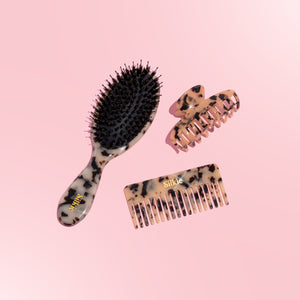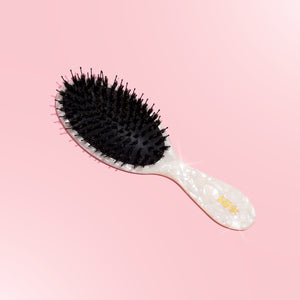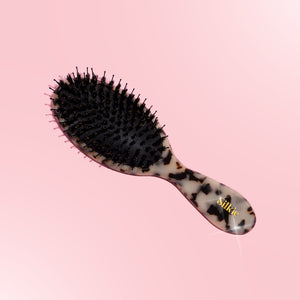The Most Sustainable Hairbrush Materials to Look For
Choosing the right hairbrush isn’t just about what works best for your hair—it’s also about making choices that are better for the planet. Many conventional hairbrushes are made with plastic handles and synthetic bristles, which contribute to waste and pollution. If you’re looking for a more eco-friendly alternative, switching to a brush made from sustainable materials is a small but impactful way to reduce your environmental footprint.
In this guide, we’ll explore the most sustainable hairbrush materials and why they’re a better choice for your hair and the environment.
Why Sustainable Hairbrush Materials Matter
Most commercial hairbrushes are made with plastic handles and nylon bristles, both of which are derived from fossil fuels and take hundreds of years to break down. These materials contribute to landfill waste, microplastic pollution, and carbon emissions.
Sustainable hairbrushes, on the other hand, are crafted from natural, biodegradable, and responsibly sourced materials. Not only are they better for the environment, but they also tend to be gentler on your hair and scalp.
Best Sustainable Materials for Hairbrushes
1. Bamboo: The Ultimate Eco-Friendly Choice
Bamboo is one of the most sustainable materials for hairbrushes because it’s fast-growing, biodegradable, and highly durable. Unlike traditional wood, bamboo grows rapidly without the need for fertilizers or pesticides, making it an excellent renewable resource.
Why Bamboo Brushes Are Great:
- 100% biodegradable, meaning they won’t contribute to plastic waste
- Strong yet lightweight, making them easy to use and travel with
- Naturally antimicrobial, helping to keep your scalp healthy
- Smooth bristles that prevent breakage and distribute natural oils evenly
2. Wood: A Classic, Long-Lasting Option
Wooden hairbrushes are another sustainable alternative to plastic brushes. When sourced from responsibly managed forests, wooden brushes offer a durable and biodegradable option for eco-conscious consumers.
Why Choose a Wooden Hairbrush:
- Gentle on the scalp, preventing irritation
- Long-lasting, reducing the need for frequent replacements
- Plastic-free bristles available, minimizing microplastic pollution
Look for brushes made from FSC-certified wood, which ensures that the material is harvested responsibly.
3. Natural Rubber: A Sustainable Cushion Base
Many eco-friendly hairbrushes use natural rubber for their cushion base instead of synthetic plastics. Natural rubber is biodegradable, durable, and provides great flexibility, making brushing more comfortable.
Benefits of Natural Rubber Cushions:
- Softens the brushing experience, preventing tugging and pulling
- Sustainably harvested, making it an eco-conscious alternative to synthetic plastics
- Non-toxic and biodegradable, reducing environmental impact
4. Boar Bristles: A Natural, Biodegradable Bristle Option
Boar bristle brushes have been used for centuries because they help distribute natural scalp oils for shinier, healthier hair. Unlike synthetic bristles, boar bristles are biodegradable and free of plastic.
Benefits of Boar Bristle Brushes:
- Enhance natural shine by spreading scalp oils from root to tip
- Gentle on hair, preventing static and breakage
- Eco-friendly and biodegradable
For a more ethical option, look for brushes with cruelty-free boar bristles, sourced responsibly without harming animals.
5. Plant-Based Bristles: A Vegan Alternative
If you prefer a vegan and cruelty-free hairbrush, opt for plant-based bristles made from materials like:
- Castor bean oil-derived nylon (a more sustainable alternative to conventional plastic bristles)
- Agave fibers, which mimic boar bristles for a similar brushing experience
Plant-based bristles offer an eco-conscious solution while ensuring that no animal products are used.
How to Choose the Right Sustainable Hairbrush
When shopping for an eco-friendly hairbrush, keep these factors in mind:
- Material Composition – Look for brushes made from bamboo, FSC-certified wood, natural rubber, or plant-based bristles.
- Durability – Choose a brush that is built to last, reducing waste over time.
- Hair Type Compatibility – Boar bristle brushes work best for fine hair, while wooden or bamboo bristles are better for thicker hair types.
- End-of-Life Disposal – Ensure the brush is fully biodegradable or recyclable when it reaches the end of its lifespan.
Sustainable Haircare Goes Beyond Just Your Brush
Switching to a sustainable hairbrush is a great step toward eco-friendly haircare, but don’t stop there! Small changes—like reducing heat styling, using refillable hair products, and sleeping on a silk pillowcase—can make a big difference in protecting both your hair and the environment.
One of the easiest ways to minimize hair damage and reduce waste is by switching to a Silkie silk pillowcase. Unlike cotton, Silkie’s 100% mulberry silk pillowcases help:
- Reduce hair breakage by eliminating friction while you sleep
- Keep hair hydrated, preventing dryness and split ends
- Extend the life of your hairstyles, reducing the need for excessive product use
By combining sustainable hair tools with protective haircare, you can maintain healthy, beautiful hair while making eco-friendly choices.
Final Thoughts: Make the Switch to Sustainable Haircare
Choosing a sustainable hairbrush is a simple yet effective way to reduce your environmental impact while keeping your hair healthy and strong. Whether it’s bamboo, wood, natural rubber, or plant-based bristles, the right eco-friendly materials can make a difference for both your beauty routine and the planet.
Looking for more ways to protect your hair while being eco-conscious? Upgrade your haircare routine with a Silkie silk pillowcase—the sustainable choice for frizz-free, hydrated hair.
Shop now at www.shopsilkie.com and experience the best in luxurious, sustainable haircare!




